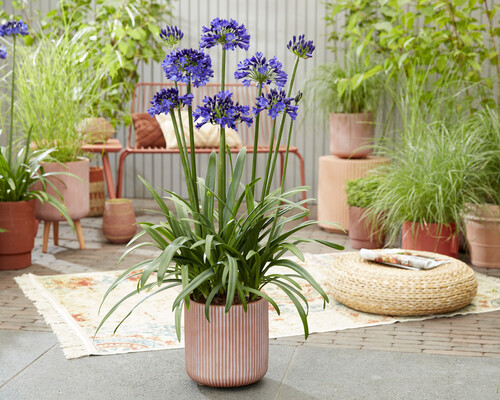Grasping the Art of Agapanthus Care: Crucial Steps for Healthy And Balanced Development and Lively Flowers
In the world of gardening, the cultivation of agapanthus stands as a gratifying endeavor for those who look for to support these classy blooming plants. From choosing the best variety to understanding pruning methods, the journey in the direction of cultivating prospering agapanthus plants is complex and holds the crucial to unlocking the complete capacity of these herb gems.

Selecting the Right Agapanthus Range

When choosing the best Agapanthus selection for your garden, think about aspects such as environment suitability, bloom color, and growth routine. Agapanthus, commonly referred to as Lily of the Nile or African lily, comes in a range of shades ranging from shades of blue and purple to white. Choose a bloom shade that complements your existing garden scheme to develop a harmonious landscape. In addition, take into consideration the climate in your region to make certain the Agapanthus variety you select can prosper in your details conditions. Some varieties are extra tolerant of cold temperatures, while others choose warmer environments. Recognizing the growth habit of various Agapanthus selections is critical for appropriate placement within your yard. Some selections have a clumping development behavior, ideal for containers or boundaries, while others have an even more spreading nature, ideal for ground cover or mass plantings. By thoroughly examining these variables, you can select the excellent Agapanthus variety to enhance the elegance of your yard.
Suitable Planting Problems
Taking into consideration the ideal ecological demands is essential for successful Agapanthus growing. Agapanthus plants are sensitive to cool temperatures and ought to be secured from frost during wintertime months.
To guarantee healthy growth and vibrant blooms, plant Agapanthus light bulbs at a depth of about 2-4 inches and space them 8-12 inches apart. Mulching around the base of the plants helps preserve wetness and subdues weed development.
Watering and Fertilizing Tips
Maintaining correct moisture degrees and offering essential nutrients are vital elements in the treatment program for Agapanthus plants. When it comes to sprinkling Agapanthus, it is crucial to strike an equilibrium. These plants like consistently wet soil however are prone to root rot if overwatered.
Feeding Agapanthus is essential for advertising healthy growth and prolific flowers. Use a balanced fertilizer, such as a 10-10-10 formula, in find the very early springtime as new growth arises. Repeat this application every 6-8 weeks throughout the growing season. Stay clear of excessive fertilizing, as it can lead to rich vegetation at the expense of flowers. Always follow the supplier's instructions for proper dilution and application techniques. By adhering to these watering and fertilizing ideas, you can guarantee your Agapanthus plants grow and generate vibrant, resilient blooms.
Trimming Strategies for Agapanthus
Trimming Agapanthus plants at the appropriate times and with proper techniques is important for preserving their health and wellness and advertising optimum development and flowering. The optimal time to prune Agapanthus remains in late winter or very early springtime before new growth emerges. Start by eliminating any yellowing or dead fallen leaves near the base of the plant. Cut them as short as feasible without damaging the emerging shoots.
Deadheading invested flowers can likewise reroute the plant's energy right into producing even more blossoms rather than establishing seeds. If you want to accumulate seeds for proliferation, leave some flowers to fully grown and dry on the plant.
Keep in mind to utilize tidy, sharp tools to make specific cuts and decrease the danger of introducing illness. Agapanthus. Regular check my site pruning will certainly aid keep your Agapanthus looking cool and healthy and balanced while making certain an abundant display screen of stunning flowers
Dealing With Typical Parasites and Illness
After making certain proper trimming methods for Agapanthus, it is vital to address usual insects and conditions that can influence the health and vitality of these plants. Agapanthus plants are normally durable however can still succumb to particular issues. One typical bug that influences Agapanthus is the Agapanthus gall midget. This small, orange fly lays its eggs in the foliage, resulting in distorted development and blossom buds that fail to open. To fight this bug, trim and ruin any kind of damaged plant components and consider using insecticidal soap.
Additionally, Agapanthus plants can experience from origin rot if they are grown in poorly draining pipes soil. By being cautious and taking timely activity against parasites and conditions, you can help your Agapanthus plants prosper and produce dynamic blooms. Agapanthus.

Conclusion
To conclude, understanding the art of agapanthus treatment entails selecting the best selection, providing optimal growing conditions, correct watering and feeding, ideal pruning methods, and attending to usual parasites and diseases. By complying with these crucial actions, you can make certain healthy growth and lively flowers for your agapanthus plants. Keep in mind to routinely check and maintain your plants to advertise their total well-being and long life.
To ensure healthy growth and dynamic blossoms, plant Agapanthus bulbs at a depth of concerning 2-4 inches and room them 8-12 inches apart. next page By adhering to these watering and fertilizing pointers, you can guarantee your Agapanthus plants prosper and generate lively, durable flowers.
One typical insect that affects Agapanthus is the Agapanthus gall midget. Furthermore, Agapanthus plants can experience from root rot if they are grown in inadequately draining pipes soil. By following these important steps, you can make certain healthy growth and vivid flowers for your agapanthus plants.